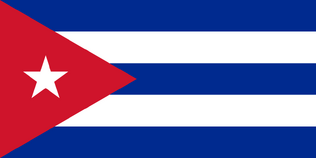
Cuba is still one of the least connected countries of the world. A trip to this Caribbean island is like walking down memory lane to a place of 30 years ago. The US embargo hindered any further development of the mobile phone system and the internet, but the easing of the restrictions from 2016 onwards brings new opportunities.
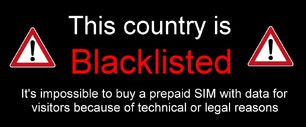
Still in 2017, don't go to Cuba, if you need a steady internet connection at an affordable price. For all other visitors, there are more ways to stay connected now. According to our rules, this country is still blacklisted, but this may change soon.
Basics
Mobile telephony in Cuba
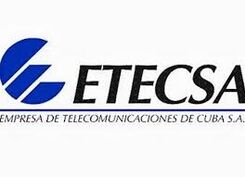
All telephone service is provided through ETECSA (for Empresa de Telecomunicaciones de Cuba S.A.) which is state-owned. It's the only player for landlines, mobile telephony and internet access on the island. In every town on the island you can find an office of ETECSA for basic services.
Mobile telephone service is provided through two different companies under the roof of ETECSA:
- Cubacel
- C-com
C-com, also called Celulares del Caribe is not accessible, so this article focuses on Cubacel.
Mobile-cellular telephone service in Cuba is expensive and must be paid in Cuban convertible pesos (CUC) by locals too, which severely limits subscribership.
Internet in Cuba
The internet in Cuba is characterized by a low number of connections, limited bandwidth, some censorship and high cost. Cuba has the lowest ratio of computers per inhabitant in Latin America and the lowest internet access ratio of all the Western hemisphere. So the main obstacle for the local population is to go online as Cuba’s domestic telecommunications infrastructure is limited in scope and only appropriate for the early days of the internet.
The island depended on a few satellite links without significant bandwidth. In 2011 the new fibre-optic cable link to Venezuela was started, but delayed for years. Since 2015 it seems to be operational and gives more speed to the few users so far. But times are changing: in 2016 ETECSA began a pilot program for broadband internet to be rolled out in a few Cuban homes in Havanna. In 2017 very high rates for home internet were announced.
Surprisingly, there is not much censorship around. Most international and social media pages are accessible. The main way of "filtering" is still the lack of access for local people, its high costs and slow speeds.
Cubacel (by ETECSA)
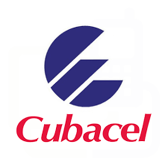
Many consider Cubacel the only mobile provider in Cuba as C-com stays invisible. Cubacel started with a TDMA-network on 800 MHz which was decommissioned in 2009.
It's today a GSM-based network on 900 MHz nationwide for 2G with additional spectrum on 850 MHz in La Habana (= Havana), Varadero, Ciego de Ávila, Cayo Coco, Cayo Guillermo and Holguín (at the airport and Guardalavaca) (see coverage map).
In some tourist centers Cubacel started to deploy a 3G network on 900 MHz for roaming customers only. At the end of 2016 Cubacel runs 829 GSM and 239 3G base stations. 3G coverage is verified in main tourist areas in these 15 provinces: Artemisa, Camagüey, Ciego de Ávila, Cienfuegos, Granma, Guantánamo, Holguín, La Habana (Havanna), Las Tunas, Manatzas, Mayabeque, Pinar del Río, Sancti Spíritus, Santiago de Cuba and Villa Clara.
It has a reasonable coverage for voice and SMS services. Mobile internet, not even GPRS, is not included in the local access through Cubacel SIM cards. Data are only open to some of their foreign roaming partners, which can use their 3G network exclusively.
For 2018 ETECSA revealed plans to deploy 4G/LTE presumably for roaming customers only. Frequencies in the 700 and 1800 MHz bands are going to be used.
ETECSA through Cubacel is logging all IMEI numbers of the devices as soon as their SIM card is put in. Anyone inserting a SIM card into a phone that appears on their blacklist of invalid IMEI codes will have their line blocked. It was forced to take action in view of "the increase in reports associated with criminal acts including theft and/or loss of mobile phones." Users with a blocked line can still have it unlocked, if they clarify the causes at an ETECSA office within 5 days.
Renting a local SIM
These rules are frequently changing. As they are now, you will not be allowed to purchase a local SIM card as a temporary visitor or tourist to the island. This is reserved to permanent residents only. But you can rent a Cubacel SIM (and possibly a phone) when you arrive in Cuba and give it back when leaving. There are Cubacel offices in terminals #2 and #3 at José Martí International Airport in Havana.
Be aware that there is generally no data on their 2G/GSM network with a local SIM card, but this may change in 2017. Voice calls and SMS services, as well as IDD calls and texts are working incoming and outgoing.
Cubacel's SIM cards come with prepaid minutes in amounts of 10, 20 or 40 Cuban convertible pesos (CUC = US$) plus a daily rental fee for the SIM card of CUC 3. You are allowed to bring your own device as long as it works on 900 MHz GSM. The maximum rental is for 45 days.
Rates are CUC 0.35 (@ daytime) and CUC 0.10 (@ nighttime) per minute for calls within Cuba and CUC 1-1.20 per minute for calls abroad. Daytime is 7am-11pm, nightime is 11pm-7am. Outgoing text messages cost CUC 0.09 to send within Cuba and CUC 0.60 to send abroad. Incoming calls and SMS are free and again internet data are not available yet.
An alternative to using your mobile phone is to rent a phone upon arrival in Cuba from Cubacel. They charge a one-time refundable deposit of CUC 100, plus a daily fee of CUC 10 for the device. Additionally, you should expect to pay all of the applicable per-minute call and text charges.
In 2017 ETECSA announced that it plans to enable 3G mobile data services for local citizens ‘in the coming weeks’, but this hasn't come true so far.
Purchasing a SIM card through a local
The purchase of SIM cards is reserved to permanent residents of Cuba and not allowed for short-time visitors. If you plan to stay more than 10 days or are a recurring visitor, you can ask a local to buy a SIM card for you and have it registered on his name.
Purchasing a Cubacel SIM costs CUC 30 and comes with CUC 10 starter credit. The same call and text rates apply as for the rental option. Again, data use is not included. The requirements for the Cuban national to comply are written here.
There are many ways to top-up Cubacell SIM cards. Recharge vouchers of CUC 5, 10 or 20 are sold in the country or go to an ETECSA office. If you want to use your credit card or do it from abroad, you can buy Cubacel recharge cards in the US, Canada or Spain or reload through Ding* or Cubacalls for a surcharge or you can use eTopUpOnline free of charge
Effective in 2014 Cubacel SIM cards and the loaded credit stay valid for 330 days past each top-up. Then there is an additional grace period of 1 month, when the SIM stays open for incoming services only, before the subscription will be terminated.
Staying on roaming with your home provider
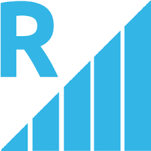
Alternatively, you may choose to stay on roaming with your home provider to get data because a local SIM doesn't provide you any. But you must be willing to pay a hefty price. Cuba is frequently listed as one of the most expensive roaming countries worldwide, just below cruise ships and satellite telephony.
Cubacel lists these roaming partners abroad (check here), but beware that not all operators include data. So you should better check with your home provider before travel. Those who include data have the benefit of an exclusive use of the data network and 3G in some tourist places like Havana and Varadero. Speed is reported to be quite reasonable, if you happen to catch a 3G cell.
All major US carriers have sealed roaming agreements with Cubacel after the boycott has been lifted. Verizon, AT&T, T-Mobile and Sprint now all sell data at around US$2 per MB without any packages offered. T-Mobile hasn't included Cuba in their 140+ countries list of free roaming at low speeds.
All Canadian providers have offered roaming services for a long time as they were not affected by the US embargo. Rogers charges CA$1.50 per MB, Telus CA$10 per MB and Bell sells a 30 MB pass at CA$75. Note, that most Canadian roaming packages are not valid in Cuba.
From Latin America and the Caribbean Movistar and Claro roam at equally high prices while some providers from Europe and the rest of the world offer data roaming in Cuba too. Roaming rates are extremely high and variable like Vodafone in Germany at €23.60 per MB, but £5 for 25 MB data a day, with £3 a MB thereafter with Vodafone UK. So check with your home provider first and look for available offers, when you decide to go for this option.
Digicel Roaming on Cubacel

In April 2017 international provider Digicel based in Jamaica partnered with ETECSA in Cuba and started to offer the so far lowest data rates in this still very expensive country. This Cuba roaming is added to some local Digicel offers in the Caribbean as well as on a special Digicel Cuba Roaming Card available to all.
Availability
The Digicel Cuba Roaming Card is directly sold through a special website or on Amazon.com for US$ 25. From their website the SIM can only be shipped to an address in the USA. But it can also be found resold on different eBay platforms for other destinations. It comes with 100 MB data for a start. Billing is per KB and on 3G where available. To activate, type *120# and store APN. SIM card is valid for 60 days past any recharge.
Data feature packages
These recharges or packages are available from their website:
- 100 MB: US$ 25
- 300 MB: US$ 50
- 500 MB plus 40 domestic mins incoming and outgoing: US$ 100
Recharge plans can only be added, once the SIM has been activated in Cuba. Automatic reload is available. If you need to be connected the rate of US$ 0.17 per MB is the lowest in the market so far.
More info
- APN: internet.ky
- Website in English: https://www.digicelcubaroaming.com/
Buying local vouchers for WiFi hotspots (Nauta)
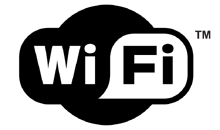
WiFi Hotspots
In 2015 ETECSA started to install WiFi hotspots throughout the country, where users can link to the internet by a WiFi connection.
In a first step 35 spots were created, but in 2016 already 317 WiFi access points have been installed in many different places (list: here in Spanish) covering all provinces. There is even one at the international airport of Havana.
1,157 public internet access places are present in 2016 and about 193 'Salas de Navegación' were created where they rent out computers with an internet connection mostly in an ETECSA office (list of places) like in webcafes. However, these places are very crowded as demand is quite high.
This is still a drop in the bucket for a country with over 11 miilion inhabitants. Access can be slow and dropped connections are common. The price is too high for most Cubans and the lines to buy time are long. Furthermore the outdoor facilities are crowded, lack privacy, exposed to rain and heat and attract criminals.
In July 2015 after lot of critisism ETECSA cut the prices by 56% and again in 2016 by 25%. A one hour access is now for CUC 1.50. Temporary residents like exchange students can apply for a permanent Nauta account that can be loaded like a prepaid account. Visitors are restricted to buy Nauta vouchers for access.
Nauta vouchers

At and around these spots Nauta vouchers are sold officially in three different denominations. In November 2017 the prices were again lowered:
- 1/2 hour: CUC 0.50
- 1 hour: CUC 1.00
- 5 hours: CUC 5.00
As all vouchers have the same base price of CUC 1 per hour, mostly the hourly voucher is available at all. You are only allowed to buy 3 vouchers at a time. The credit is valid for 30 days after the first connection.
There are sometimes long lines in front of the counters. That's why around many spots a 'secondary market' has been established. You will be offered the same cards for a surcharge at e.g. CUC 2-3. This is illegal, but common practice to skip the long lines. Just check, that your password hasn't been scratched off before. Furthermore, be aware that thefts and robberies of cellphones and laptops have occured at these places. That's something which hasn't been seen before in Cuba.
Connecting to a Cuban Hotspot
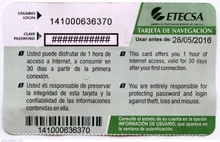
To connect to a Cuban hotspot you need to go to one of their hotspot areas which you can easily find by users hanging around or checking the list and looking at a map.
You'll need to buy a Nauta card and bring your own device. Then connect to WIFI_ETECSA ignoring an aged security certificate. You will be directed to their landing page. The Nauta card has a log on code and password which you scatch off and enter.
You need to log off manually or will lose the rest of your credit otherwise. To log off type 1.1.1.1 into the search bar. Here you request to log off and click ‘cerrar sesión’. If you have not used your full hour then the remaining credit will be available for you to use later. When service breaks down and you will not be able to log off, you can forget the rest of your credit.
To get the most out of the internet in Cuba, prepare your e-mails in ‘Draft’ format and they’ll be ready to go when you connect to the Cuban internet. If you’re an avid social media user, prepare your tweets in advance and your Instagram pictures. Be prepared to know which websites you’ll be able to visit and have a plan of attack as soon as you connect to the internet because the time is ticking.
Issues with Cuban Hotspots
Accessibility is not only restricted to where you log on, but the strenght of the WiFi is not always great. It’s sometimes slow and can stop working for days in places. Many factors affect your connection and speed: distance to the hotspot router, numbers of users on it, even bad weather.
You need to check your email through the web to be able to send and receive mails, if you use Outlook Express or the Email icon, you will be able to receive mails but not to send, as SMTP server for clients are not supported.
You can't use Facetime, Snapchat or Skype in Cuba. WhatsApp works, even for VoIP, but locals mostly use the app/software IMO for VoIP calls abroad and given enough speed even for video chats.
Some users made a surprising discovery: Their high-end Android devices simply refused to connect to the ETECSA hotspot. This only happened to certain Samsung S3, S4 and S5 Edge (but not mini) and Galaxy Note 4 models. The reason is ridiculous and confirmed now: These devices have an in-built Broadcom 802.11ac chipset for '5G WiFI'. As a former US-company (now sold to Singapore) it was required to obey the US embargo. So every time the device understands that it's located in Cuba, the chip stops working. It's likely that other Android high-end devices like the HTC one or LG Nexus 5 and some routers are affected too, but you are clear with any Android without it or any iOS or Windows Phone.
Other WiFi hotspots
There are 615 3rd party locations as in many international hotels in Havana, Varadero and other resorts that either sell Nauta cards (sometimes for a surcharge and some consumption, if you are not staying there) or own internet passes for their own WiFi in the hotel lobby. Prices range around CUC 2-10 per hour and access policy varies. It’s still very rare to find internet access in your hotel room aside from the hotel lobby. On the other side internet speeds in some hotel lobbys are reported to be astonishingly high.
